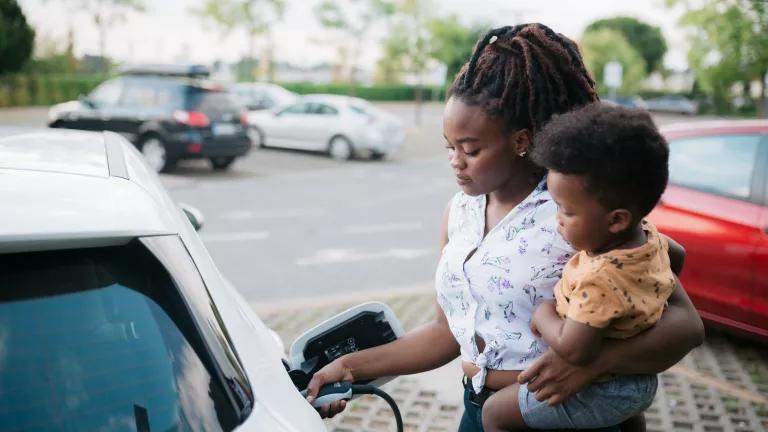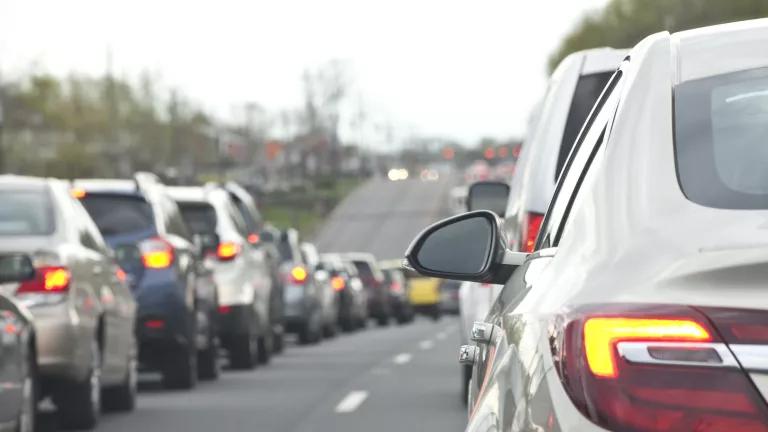Clean Cars Can Bring $97 Billion in Benefits to New Jersey
A new study shows that the Advanced Clean Cars II Program can bring over $97 billion in benefits to New Jersey.

This blog has been co-authored by Alison Kirsch from the Sierra Club.
The Garden State has an important opportunity to provide significant air quality, health, and economic benefits to the state.
In February, New Jersey Governor Phil Murphy announced a suite of new initiatives that would accelerate the state’s climate mitigation and adaptation efforts. Among these was the intention to adopt Advanced Clean Cars II (ACC II), an important program that will get the ball rolling on rapid deployment of zero-emission light-duty vehicles (LDVs) in New Jersey. Under ACC II, manufacturers would sell increasingly higher percentages of new zero-emission vehicles (ZEVs) in each model year (MY), namely 43 percent new ZEV sales in MY 2027 and eventually 100 percent new ZEV sales in MY 2035. In this case, ZEVs include battery electric vehicles, plug-in hybrid electric vehicles, and fuel cell electric vehicles.
Commissioned by the Sierra Club and the Natural Resources Defense Council (NRDC), new analysis from ERM aggregates the potential public health, environmental, and economic impacts of ACC II in New Jersey under different scenarios. Two of the scenarios assume that the electric grid becomes 100 percent zero-emitting by 2035, another major target of the governor’s initiatives.
Policy Scenarios
The report evaluated the following scenarios:
- Business As Usual (BAU): All new LDVs sold in New Jersey continue to meet existing vehicle standards. ZEV sales increase but are capped at one-third of new vehicle sales each year.
- ACC II Flex: New Jersey adopts ACC II starting in MY 2027, and vehicle manufacturers use many of the available compliance flexibilities such that they sell fewer ZEVs than is nominally required by the regulation.
- ACC II Flex + Clean Grid: New Jersey adopts ACC II starting in MY 2027 and reaches 100 percent clean electricity generation by 2035. Manufacturers use many of the available compliance flexibilities.
- ACC II Full + Clean Grid: New Jersey adopts ACC II in MY 2027 and reaches 100 percent clean electricity generation by 2035. Manufacturers do not use any of the compliance flexibilities.
Public Health and the Environment
Compared to the BAU scenario, by 2050 the ACC II scenarios with a clean grid are estimated to reduce annual LDV fleet NOx emissions by 93 percent and PM emissions by 92 percent. The impact on New Jersey residents cannot be understated. It comes down to cleaner air and better health: The resulting cumulative public health benefits between 2027 and 2050 include 175 to 358 fewer premature deaths, 170 to 362 fewer hospital visits, and 100,063 to 212,349 fewer minor cases of illness. The monetized values of these public health benefits total $2.1 billion to $4.4 billion.
Compared to the BAU scenario, under the ACC II scenarios cumulative greenhouse gas (GHG) emission reductions from New Jersey’s LDV fleet reach between 156 and 243 million metric tons of CO2e from 2027 through 2050. The benefits of these GHG emissions reductions are valued at $13 billion to $19 billion.
Economic Impacts
At the start of ACC II, in MY 2027, the average light-duty ZEV in New Jersey will save its owner approximately $14,000 in lifetime costs compared to a conventional vehicle. Drivers purchasing a ZEV in MY2030 could save up to $16,100 in lifetime costs. After MY 2030, the average ZEV will still offer over $14,000 in lifetime savings despite projected increases in electricity rates. For rural New Jerseyans, who are assumed to prefer a longer-range ZEV with higher up-front costs, an MY 2027 ZEV will save its owner $5,300 over its lifetime compared to a gasoline vehicle, and for an MY 2030 ZEV, lifetime costs become about $13,500 lower. Rural drivers of ZEVs purchased after MY 2030 will enjoy total savings of more than $17,000.
Under the ACC II Flex scenarios, annual net utility revenue from light-duty electric vehicle charging is projected to be $47 million in 2030, $629 million in 2040, and $960 million in 2050. The ACC II Full + Clean Grid scenario doubles net utility revenue in 2030 to $102 million, with $660 million in revenue in 2040, and $964 million in 2050.
Since ACC II will likely increase utility net revenue as it electrifies New Jersey’s LDV fleet, New Jersey’s average residential and commercial rates could be 7.5 percent lower by 2050. The average New Jersey household could therefore save $174 each year on its electricity bill, and the average commercial customer $728 each year.
The deployment of ZEV charging infrastructure will also bring substantial investments to the state. Implementing ACC II in New Jersey will require more than 3 million in-use charge ports. Purchasing and installing these chargers will bring more than $6 billion in cumulative investment by 2050.
In terms of job benefits, adoption of ACC II will result in a net increase of approximately 6,400 jobs by 2050. Average wages for the new jobs created are expected to be about one-third higher than average wages for the jobs that will be replaced.
Conclusion
Taken together, the cumulative net societal benefits by 2050 reach $84.3 billion under the ACC II Flex scenario, $92 billion under the ACC II Flex + Clean Grid scenario, and $96.9 billion under the ACC II Full + Clean Grid scenario. To fully capture these benefits, New Jersey must adopt ACC II before the end of this year so that it applies to MY 2027, and it is critical that the state adopt the program through its 2035 endpoint. This way, New Jersey can fully take advantage of the significant public health, climate, and economic benefits from the state’s transition to a clean transportation system.



